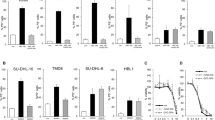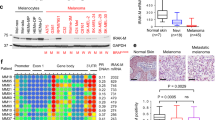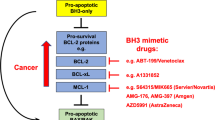Abstract
The proapoptotic BH3-only protein natural born killer / Bcl-2 interacting killer (Nbk / Bik) has been described to inhibit Bcl-2 and Bcl-xL, thereby supporting the death promoting ability of Bax. In order to evaluate its function in melanoma, we investigated the response after Nbk / Bik overexpression in cultured human melanoma cells and in a melanoma mouse model. Untransfected melanoma cell lines expressed Nbk / Bik only weakly at the mRNA and protein level. Conditional expression of Nbk / Bik by applying the inducible tetracycline-responsive expression system triggered apoptosis and enhanced sensitivity to proapoptotic stimuli as to agonistic CD95 activation and to chemotherapeutics etoposide, doxorubicin and pamidronate. For investigating the effects of Nbk / Bik in vivo, stably transfected melanoma cells were subcutaneously injected into nude mice. Significantly delayed tumor growth was the result when mice received doxycycline for induction of Nbk / Bik expression. By investigating the mechanism of Nbk / Bik-induced cell death, typical hallmarks of apoptosis such as DNA fragmentation and chromatin condensation were seen after induction. Interestingly, no indications for cytochrome c release and caspase processing were found, and selective caspase inhibition remained without effect. These data indicate the high potential of Nbk / Bik in regulating apoptosis in melanoma by a caspase-independent pathway and may corroborate the potency of novel antimelanoma strategies based on activation of BH3-only proteins such as Nbk / Bik.
This is a preview of subscription content, access via your institution
Access options
Subscribe to this journal
Receive 50 print issues and online access
$259.00 per year
only $5.18 per issue
Buy this article
- Purchase on Springer Link
- Instant access to full article PDF
Prices may be subject to local taxes which are calculated during checkout









Similar content being viewed by others
References
Bang B, Baadsgaard O, Skov L and Jaattela M . (2004). Arch. Dermatol. Res., 296, 67–73.
Borner C . (2003). Mol. Immunol., 39, 615–647.
Bouillet P, Cory S, Zhang LC, Strasser A and Adams JM . (2001). Dev. Cell, 1, 645–653.
Boyd JM, Gallo GJ, Elangovan B, Houghton AB, Malstrom S, Avery BJ, Ebb RG, Subramanian T, Chittenden T, Lutz RJ and Chinnadurai G . (1995). Oncogene, 11, 1921–1928.
Broker LE, Huisman C, Span SW, Rodriguez JA, Kruyt FA and Giaccone G . (2004). Cancer Res., 64, 27–30.
Bruggen J, Fogh J and Sorg C . (1981). J. Cancer Res. Clin. Oncol., 102, 141–152.
Carey TE, Takahashi T, Resnick LA, Oettgen HF and Old LJ . (1976). Proc. Natl. Acad. Sci. USA, 73, 3278–3282.
Coultas L, Bouillet P, Stanley EG, Brodnicki TC, Adams JM and Strasser A . (2004). Mol. Cell. Biol., 24, 1570–1581.
Daniel PT, Pun KT, Ritschel S, Sturm I, Holler J, Dorken B and Brown R . (1999). Blood, 94, 1100–1107.
Daniel PT, Schulze-Osthoff K, Belka C and Guner D . (2003). Essays Biochem., 39, 73–88.
Eberle J, Fecker LF, Bittner JU, Orfanos CE and Geilen CC . (2002). Br. J. Cancer, 86, 1957–1962.
Eberle J, Fecker LF, Hossini AM, Wieder T, Daniel PT, Orfanos CE and Geilen CC . (2003). Oncogene, 22, 9131–9141.
Eberle J, Weitmann S, Thieck O, Pech H, Paul M and Orfanos CE . (1999). J. Invest. Dermatol., 112, 925–932.
Eisinger M and Marko O . (1982). Proc. Natl. Acad. Sci. USA, 79, 2018–2022.
Elangovan B and Chinnadurai G . (1997). J. Biol. Chem., 272, 24494–24498.
Fecker LF, Geilen CC, Hossini AM, Schwarz C, Fechner H, Bartlett DL, Orfanos CE and Eberle J . (2005). J. Invest. Dermatol., 124, 221–228.
Festjens N, van Gurp M, van Loo G, Saelens X and Vandenabeele P . (2004). Acta Haematol., 111, 7–27.
Fischer U, Janicke RU and Schulze-Osthoff K . (2003). Cell Death Differ., 10, 76–100.
Fischer U and Schulze-Osthoff K . (2005). Cell Death Differ. (in press).
Foghsgaard L, Wissing D, Mauch D, Lademann U, Bastholm L, Boes M, Elling F, Leist M and Jaattela M . (2001). J. Cell Biol., 153, 999–1010.
Garbe C and Blum A . (2001). Skin Pharmacol. Appl. Skin Physiol., 14, 280–290.
Germain M, Mathai JP and Shore GC . (2002). J. Biol. Chem., 277, 18053–18060.
Gillissen B, Essmann F, Graupner V, Starck L, Radetzki S, Dorken B, Schulze-Osthoff K and Daniel PT . (2003). EMBO J., 22, 3580–3590.
Gossen M and Bujard H . (1992). Proc. Natl. Acad. Sci. USA, 89, 5547–5551.
Guner D, Belka C and Daniel PT . (2003). Curr. Med. Chem. Anti-Cancer Agents, 3, 319–326.
Han J, Sabbatini P and White E . (1996). Mol. Cell. Biol., 16, 5857–5864.
Hossini AM, Eberle J, Fecker LF, Orfanos CE and Geilen CC . (2003). FEBS Lett., 553, 250–256.
Hur JY, Chesnes J, Coser KR, Lee RS, Geck P, Isselbacher KJ and Shioda T . (2004). Proc. Natl. Acad. Sci. USA, 101, 2351–2356.
Hussein MR, Haemel AK and Wood GS . (2003). J. Pathol., 199, 275–288.
Igney FH and Krammer PH . (2002). Nat. Rev. Cancer, 2, 277–288.
Jiang AM and Clark EA . (2001). J. Immunol., 166, 6025–6033.
Juin P, Geneste O, Raimbaud E and Hickman JA . (2004). Biochim. Biophys. Acta, 1644, 251–260.
Lockshin A, Giovanella BC, De Ipolyi PD, Williams Jr LJ, Mendoza JT, Yim SO and Stehlin Jr JS . (1985). Cancer Res., 45, 345–350.
Mathai JP, Germain M, Marcellus RC and Shore GC . (2002). Oncogene, 21, 2534–2544.
Naumann U, Schmidt F, Wick W, Frank B, Weit S, Gillissen B, Daniel P and Weller M . (2003). Hum. Gene Ther., 14, 1235–1246.
Nicoletti I, Migliorati G, Pagliacci MC, Grignani F and Riccardi C . (1991). J. Immunol. Methods, 139, 271–279.
Orth R and Dixit VM . (1997). J. Biol. Chem., 272, 8841–8844.
Paquet C, Schmitt E, Beauchemin M and Bertrand R . (2004). Apoptosis, 9, 815–831.
Radetzki S, Kohne CH, von Haefen C, Gillissen B, Strum I, Dorken B and Daniel PT . (2002). Oncogene, 21, 227–238.
Raisova M, Bektas M, Wieder T, Daniel P, Eberle J, Orfanos CE and Geilen CC . (2000). FEBS Lett., 473, 27–32.
Raisova M, Hossini AM, Eberle J, Riebeling C, Wieder T, Sturm I, Daniel PT, Orfanos CE and Geilen CC . (2001). J. Invest. Dermatol., 117, 333–340.
Reed JC, Doctor KS and Godzik A . (2004). Sci. STKE, 2004, re9.
Riedl SJ and Shi Y . (2004). Nat. Rev. Mol. Cell Biol., 5, 897–907.
Scholz C, Wieder T, Starck L, Essmann F, Schulze-Osthoff K, Dorken B and Daniel PT . (2005). Oncogene, 24, 1904–1913.
Schotte P, Declercq W, Van Huffel S, Vandenabeele P and Beyaert R . (1999). FEBS Lett., 442, 117–121.
Soengas MS and Lowe SW . (2003). Oncogene, 22, 3138–3151.
Suzuki M, Hisamatsu T and Podolsky DK . (2003). Infect. Immunol., 71, 3503–3511.
Theodorakis P, Lomonosova E and Chinnadurai G . (2002). Cancer Res., 62, 3373–3376.
Tong Y, Yang Q, Vater C, Venkatesh LK, Custeau D, Chittenden T, Chinnadurai G and Gourdeau H . (2001). Mol. Cancer Therapeut., 1, 95–102.
van Loo G, Saelens X, van Gurp M, MacFarlane M, Martin SJ and Vandenabeele P . (2002). Cell Death Differ., 9, 1031–1042.
Verma S, Zhao LJ and Chinnadurai G . (2001). J. Biol. Chem., 276, 4671–4676.
Wieder T, Orfanos CE and Geilen CC . (1998). J. Biol. Chem., 273, 11025–11031.
Acknowledgements
Malte Oppermann was a recipient of a scholarship from the Deutsche Forschungsgemeinschaft (GRK 276 / 3). The study was further supported by the Deutsche Krebshilfe / Mildred-Scheel-Stiftung (Grant 10–1434-Eb1 / 2), the Deutsche Forschungsgemeinschaft (SFB 366, TP B8) and the Sonnenfeld-Stiftung, Berlin.
Author information
Authors and Affiliations
Corresponding author
Rights and permissions
About this article
Cite this article
Oppermann, M., Geilen, C., Fecker, L. et al. Caspase-independent induction of apoptosis in human melanoma cells by the proapoptotic Bcl-2-related protein Nbk / Bik. Oncogene 24, 7369–7380 (2005). https://doi.org/10.1038/sj.onc.1208890
Received:
Revised:
Accepted:
Published:
Issue Date:
DOI: https://doi.org/10.1038/sj.onc.1208890
Keywords
This article is cited by
-
BIK drives an aggressive breast cancer phenotype through sublethal apoptosis and predicts poor prognosis of ER-positive breast cancer
Cell Death & Disease (2020)
-
The critical roles of endoplasmic reticulum chaperones and unfolded protein response in tumorigenesis and anticancer therapies
Oncogene (2013)
-
Photosensitizing and radiosensitizing effects of mitoxantrone: combined chemo-, photo-, and radiotherapy of DFW human melanoma cells
Lasers in Medical Science (2013)
-
Disruption of the VDAC2–Bak interaction by Bcl-xS mediates efficient induction of apoptosis in melanoma cells
Cell Death & Differentiation (2012)
-
BH3-only protein Bik is involved in both apoptosis induction and sensitivity to oxidative stress in multiple myeloma
British Journal of Cancer (2010)



